Let’s face it: screens are everywhere. From educational apps to animated learning games, tech companies promise that your child can “learn while playing.” And while that sounds like a win-win, there’s something missing—real, hands-on learning.
That’s where STEM toys shine.
They don’t just entertain kids—they teach them how to think, build, experiment, and persist. Unlike passive screen time, STEM toys offer real-world challenges and development benefits that you just can’t swipe or tap your way through.
Let’s break down what STEM toys really teach—and why they go far beyond what screens can offer.
1. Problem Solving Through Trial and Error
STEM toys require kids to tinker. Build. Break. Try again. Unlike apps that provide hints, rewards, and level-ups with every few taps, STEM toys encourage failure as part of the process.
Kids learn:
- That mistakes are valuable
- How to change strategies
- To persevere through frustration
These lessons build resilience and patience—something screens rarely foster.
2. Spatial Reasoning and Fine Motor Skills
When your child builds with magnetic tiles, connects circuits, or assembles a robot, they’re using their hands, eyes, and brain together. These physical skills support:
- Hand-eye coordination
- Precision and dexterity
- 3D thinking and visualization
Screens may teach shapes or directions, but STEM toys let kids feel and create them in real space.
3. Independent Thinking and Initiative
STEM toys don’t walk your child through every step. That’s intentional. The best ones invite exploration:
- “What happens if I do this?”
- “How can I make this better?”
- “What should I build next?”
There’s no animated character rewarding each move—just curiosity, creativity, and intrinsic motivation.
4. Real Scientific and Engineering Concepts
Many STEM toys introduce age-appropriate versions of real science and engineering:
- Snap Circuits = electricity and circuitry
- Gravity Maze = force and motion
- Building kits = structural stability and mechanics
Screens might show the concept, but STEM toys let kids experiment with it directly.
5. Social and Collaborative Learning
When kids work on STEM challenges together, they:
- Share ideas
- Take turns
- Problem-solve as a team
Screens tend to isolate. STEM toys, especially open-ended ones, create space for group exploration, sibling collaboration, or even parent-child bonding.
6. Creative Thinking and Open-Ended Play
Many STEM toys don’t have a “right answer.” They’re designed for:
- Free exploration
- Building new designs
- Imagining new uses
This nurtures creativity, confidence, and flexibility—skills that are crucial for future success in any field.
7. Delayed Gratification
Screens are all about instant rewards. STEM toys, on the other hand, delay gratification. Kids may work for 10, 20, or even 30 minutes before a project comes together.
This helps them:
- Stay focused longer
- Feel pride in their effort
- Develop self-control
It’s a quiet but powerful way to build lifelong learning habits.
Final Thoughts
Screens aren’t evil—and yes, some educational apps are great in moderation. But they can’t replace the hands-on, minds-on experience that STEM toys provide.
If you want your child to think deeply, explore boldly, and build real-world skills, a STEM toy is worth far more than another app download.
So next time you’re torn between tablet time and toy time? Choose the toy that teaches your child how to think, not just what to tap.





